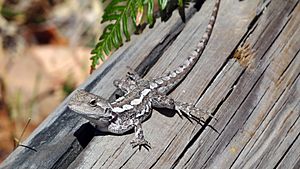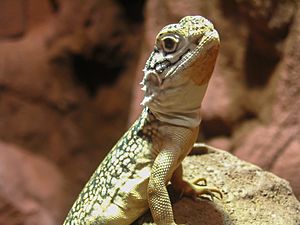Ctenophorus facts for kids
Quick facts for kids Ctenophorus |
|
|---|---|
 |
|
| Ctenophorus fordi, Mallee dragon | |
| Scientific classification |
|
| Kingdom: | Animalia |
| Phylum: | Chordata |
| Class: | Reptilia |
| Order: | Squamata |
| Suborder: | Iguania |
| Family: | Agamidae |
| Subfamily: | Amphibolurinae |
| Genus: | Ctenophorus Fitzinger, 1843 |
| Species | |
|
33 species, see text |
|
Ctenophorus is a group of lizards found in Australia. They are often called comb-bearing dragons because of their unique features. This group includes the most different types of dragon lizards in Australia. In fact, it's the largest group of Australian lizards!
These lizards live mostly in dry areas of Australia. Many of them look quite similar, which can make them tricky to tell apart. People sometimes give them fun, informal names like rock-dragon, sand-dragon, or bicycle-dragon. These names come from the mythical creature, the dragon, because of their lizard-like appearance.
It's easy to mix up Ctenophorus lizards with other lizard groups like Tympanocryptis and Diporiphora.
What Kinds of Ctenophorus Are There?
There are 33 known species of Ctenophorus lizards. Each one has its own special features and lives in different parts of Australia. Here are a few examples:
- Ctenophorus fordi – This is the Mallee dragon, often found in sandy areas.
- Ctenophorus cristatus – Known as the crested bicycle-dragon, it has a crest on its back.
- Ctenophorus decresii – Called the tawny crevice dragon, it likes to hide in rocky cracks.
- Ctenophorus nuchalis – This is the central netted dragon, famous for its cool patterns.
- Ctenophorus ornatus – The ornate dragon is known for its beautiful colors.
- Ctenophorus maculosus – This is the Lake Eyre dragon, which lives near salt lakes.
Why Do Ctenophorus Lizards Have Different Colors?
Many Ctenophorus lizards can show different colors within the same group. This is called color polymorphism. It means you might see lizards of the same species with different color patterns.
Scientists believe these different colors help the lizards in two main ways:
- Attracting Mates: Bright or unique colors can help male lizards attract female lizards. This is part of something called sexual selection.
- Staying Safe: Different colors can also help lizards blend in with their surroundings or stand out to warn predators. This is part of natural selection, where traits that help an animal survive and reproduce become more common.
So, the amazing variety of colors in Ctenophorus lizards helps them both find partners and survive in their environment!
See also
 In Spanish: Ctenophorus para niños
In Spanish: Ctenophorus para niños


